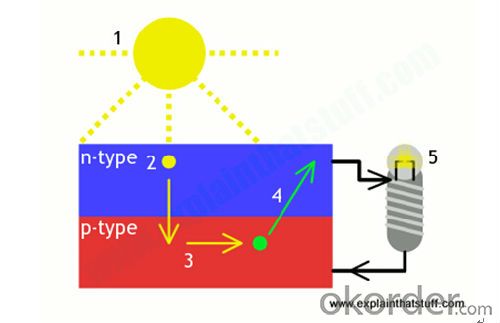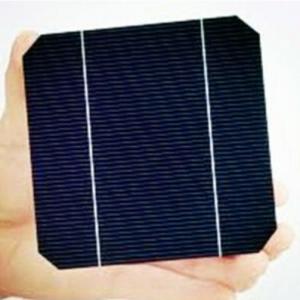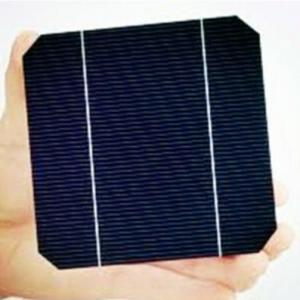Solar Cell for Solar Panel Monocrystalline and Polycrystalline 156
- Loading Port:
- China main port
- Payment Terms:
- TT or LC
- Min Order Qty:
- 100000 watt
- Supply Capability:
- 10000000 watt/month
OKorder Service Pledge
OKorder Financial Service
You Might Also Like
1. Structure of Solar Cell for Solar Panel Monocrystalline and Polycrystalline 156
A solar cell, or photovoltaic cell, is an electrical device that converts the energy of light directly into electricity by the photovoltaic effect, which
is a physical and chemical phenomenon.
It is a form of photoelectric cell, defined as a device whose electrical characteristics, such as current, voltage, or resistance, vary when exposed to light.
Solar cells are the building blocks of photovoltaic modules, otherwise known as solar panels.

2. Main Features of the Solar Cell for Solar Panel Monocrystalline and Polycrystalline 156
• 16.8%~18.25% high efficiency
• 100% checked quality
• SO9001/ISO14001/TUV/UL
• fast lead time
3. Solar Cell for Solar Panel Monocrystalline and Polycrystalline 156 Images


4. Solar Cell for Solar Panel Monocrystalline and Polycrystalline 156 Specification
poly 156 cell Electrical Characteristics( solar cell for solar panel ) | ||||||||||||
Efficiency(%) | 18 | 17.8 | 17.6 | 17.4 | 17.2 | 16.8 | 16.6 | 16.4 | 16.2 | 16 | 15.8 | 15.6 |
Pmpp(W) | 4.33 | 4.29 | 4.24 | 4.19 | 4.14 | 4.09 | 4.04 | 3.99 | 3.94 | 3.9 | 3.86 | 3.82 |
Umpp(V) | 0.53 | 0.527 | 0.524 | 0.521 | 0.518 | 0.516 | 0.514 | 0.511 | 0.509 | 0.506 | 0.503 | 0.501 |
Impp(A) | 8.159 | 8.126 | 8.081 | 8.035 | 7.99 | 7.938 | 7.876 | 7.813 | 7.754 | 7.698 | 7.642 | 7.586 |
Uoc(V) | 0.633 | 0.631 | 0.628 | 0.625 | 0.623 | 0.62 | 0.618 | 0.617 | 0.615 | 0.613 | 0.611 | 0.609 |
Isc(A) | 8.709 | 8.677 | 8.629 | 8.578 | 8.531 | 8.478 | 8.419 | 8.356 | 8.289 | 8.22 | 8.151 | 8.083 |
mono 156 Electrical Characteristics( solar cell for solar panel ) | ||||||||||||
Efficiency(%) | 20 | 19.2 | 19 | 18.8 | 18.6 | 18.4 | 18.2 | 18 | 17.8 | 17.6 | 17.4 | 17.2 |
Pmpp(W) | 4.59 | 4.54 | 4.49 | 4.45 | 4.4 | 4.35 | 4.3 | 4.26 | 4.21 | 4.16 | 4.11 | 4.08 |
Umpp(V) | 0.541 | 0.54 | 0.538 | 0.535 | 0.533 | 0.53 | 0.527 | 0.523 | 0.519 | 0.518 | 0.516 | 0.514 |
Impp(A) | 8.484 | 8.407 | 8.346 | 8.318 | 8.255 | 8.208 | 8.159 | 8.145 | 8.112 | 8.031 | 7.95 | 7.869 |
Uoc(V) | 0.64 | 0.639 | 0.638 | 0.637 | 0.636 | 0.634 | 0.632 | 0.631 | 0.63 | 0.629 | 0.628 | 0.627 |
Isc(A) | 8.972 | 8.959 | 8.936 | 8.912 | 8.875 | 8.83 | 8.805 | 8.787 | 8.775 | 8.695 | 8.615 | 8.535 |
5. FAQ of Solar Cell for Solar Panel Monocrystalline and Polycrystalline 156
Q1. How long can we receive the product after purchase?
A1.In the purchase of product within three working days, We will arrange the factory delivery as soon as possible. The pecific time of
receiving is related to the state and position of customers
Q2. Can we visit your factory?
A2:Surely, I will arrange the trip basing on your business schedule.
Most Common Uses of Solar Cells
Perhaps the most popular use of solar energy is one that doesn't involve technology at all: drying wet things. People around the world depend upon the sun to dry everything from laundry to crops. It's an effective way to achieve a goal without relying upon electricity.
It may seem unusual, but solar power has become a popular way to provide power to lighting systems that activate after the sun goes down. From street lights to garden lamps, solar power provides the energy needed to illuminate the darkness late into the night. These lights contain batteries that charge during the day as sunlight hits the solar cells. At night, a photoresistor detects the absence of light and a circuit board triggers the batteries to discharge and provide power to LED lights, which are efficient and bright.
Solar cells are very useful in powering space vehicles such as satellites and telescopes (e.g. Hubble). They provide a very economical and reliable way of powering objects which would otherwise need expensive and cumbersome fuel sources.
The above design for a solar cell array in space features many inflatable, fresnel reflectors which focus the Sun's light on small arrays of high efficiency cells.
The international space station is also another good example of solar cells being used in space. When it is finished, the station will have the most powerful solar array in space. Four sets of gold coloured wings (each one being 72 metres long and larger than the space station itself) will contain 250,000 solar cells and the whole array will be able to power a small neighbourhood. Some of the energy will be used immediately, such as in life support machines while some will be stored in batteries for when the station is not in use.
Solar cells are also being used to power the rovers which will be examining the surface of Mars in early 2004.
- Q:Can solar cells be used in countries with limited sunlight?
- Yes, solar cells can still be used in countries with limited sunlight. While it is true that solar cells generate more electricity in areas with abundant sunlight, they can still function and produce energy in regions with less sunlight. Advances in solar panel technology, such as the use of more efficient materials and improved designs, have made it possible to harness solar power even in countries with limited sunlight. Additionally, the use of energy storage systems, like batteries, can help store excess energy generated during peak sunlight hours for use during low-light periods. Therefore, solar cells can still be a viable and sustainable energy solution in countries with limited sunlight.
- Q:How do solar cells impact air pollution?
- Solar cells have a positive impact on air pollution as they produce clean and renewable energy, reducing the reliance on fossil fuels. By generating electricity from sunlight, solar cells help to decrease the emission of harmful pollutants and greenhouse gases that contribute to air pollution and climate change.
- Q:What is the typical warranty for solar cells?
- The typical warranty for solar cells varies, but it is commonly around 25 to 30 years for the performance warranty and 10 to 15 years for the product warranty.
- Q:How do solar cells perform in extreme temperatures?
- Solar cells can be affected by extreme temperatures, both hot and cold. High temperatures can decrease the efficiency of solar cells and reduce their power output, while very low temperatures can also impact their performance. However, modern solar cell technologies have been developed to minimize these effects and ensure better performance even in extreme temperatures.
- Q:What is the role of solar cells in powering remote monitoring systems?
- Solar cells play a crucial role in powering remote monitoring systems by harnessing energy from the sun and converting it into electrical power. This ensures that these systems can operate efficiently and independently in remote locations where access to a traditional power grid may not be feasible or reliable. The solar cells collect sunlight and convert it into electricity, which is then stored in batteries or used directly to power the monitoring equipment. This sustainable and renewable energy source enables continuous operation of remote monitoring systems, making them more reliable and cost-effective in monitoring and collecting data in areas with limited or no access to conventional power sources.
- Q:Why and what is the low efficiency solar cell?
- The technical problems will cause the low efficienct of the solar cells, including solar and thermal energy, solar cells are now either absorb light energy, or absorb heat, there is little light and heat absorbed together.
- Q:Can solar cells be used for powering electric water heaters?
- Yes, solar cells can be used to power electric water heaters. By harnessing sunlight and converting it into electricity, solar cells can provide a sustainable and renewable energy source to heat water in electric heaters. This helps reduce reliance on traditional power grids and contributes to a greener and more eco-friendly way of heating water.
- Q:What are the safety considerations for installing solar cells?
- Some safety considerations for installing solar cells include proper handling of the panels to avoid damage or injury, ensuring that electrical connections are correctly installed to prevent electrical hazards, and complying with local building codes and regulations. Additionally, it is essential to work with a qualified installer or electrician who is trained in solar installations to minimize any potential risks.
- Q:How are solar cells tested for quality?
- Solar cells are tested for quality through a series of rigorous evaluations and inspections. These tests typically involve measuring the electrical performance, efficiency, and durability of the cells. They are subjected to various environmental conditions, such as extreme temperatures and humidity, to ensure they can withstand different climates. Additionally, visual inspections are conducted to check for any manufacturing defects or physical damages. Overall, these quality tests help determine if the solar cells meet the required standards for optimal performance and reliability.
- Q:Can solar cells be used to power refrigeration systems?
- Yes, solar cells can be used to power refrigeration systems. Solar cells convert sunlight into electricity, which can be used to power various appliances and systems, including refrigeration systems. This method of powering refrigeration systems is environmentally friendly and sustainable.
1. Manufacturer Overview |
|
|---|---|
| Location | |
| Year Established | |
| Annual Output Value | |
| Main Markets | |
| Company Certifications | |
2. Manufacturer Certificates |
|
|---|---|
| a) Certification Name | |
| Range | |
| Reference | |
| Validity Period | |
3. Manufacturer Capability |
|
|---|---|
| a)Trade Capacity | |
| Nearest Port | |
| Export Percentage | |
| No.of Employees in Trade Department | |
| Language Spoken: | |
| b)Factory Information | |
| Factory Size: | |
| No. of Production Lines | |
| Contract Manufacturing | |
| Product Price Range | |
Send your message to us
Solar Cell for Solar Panel Monocrystalline and Polycrystalline 156
- Loading Port:
- China main port
- Payment Terms:
- TT or LC
- Min Order Qty:
- 100000 watt
- Supply Capability:
- 10000000 watt/month
OKorder Service Pledge
OKorder Financial Service
Similar products
New products
Hot products
Hot Searches
Related keywords































